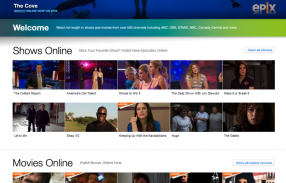 The Over-the-Air Reception Devices (OTARD) Rule was created to promote a fair and competitive consumer television reception market. The OTARD Rule (47 C.F.R. Section 1.4000) has been in effect since October 1996, and it prohibits restrictions that impair the installation, maintenance or use of antennas used to receive video programming. Check out the FCC website for more information. The OTARD Rule Covers: A “dish” antenna that is one meter (39.37”) or less in diameter (or any size dish if located in Alaska) including direct-to-home satellite dishes, TV antennas, wireless cable antennas and customer-end antennas that receive and transmit fixed wireless signals The OTARD Rule applies to most state and local laws and landlord or community association rules that contain dish restrictions that: • Unreasonably delay or prevent installation, maintenance or use. • Unreasonably increase the cost of installation, maintenance or use. • Preclude a person from receiving or transmitting an acceptable quality signal from an antenna covered under the Rule. A consumer’s use of a covered dish antenna is protected by the OTARD Rule if: • Placement of a dish is in the resident’s (owner or renter) exclusive use area, such as a balcony, deck, garden, yard or patio. • Placement of a dish is wholly within the user’s exclusive use area. State and local laws and landlord and community association rules generally CANNOT: • Require prior approval or a permit. • Require any type of permit or prior approval fee. State and local laws and landlord and community association rules generally MAY: • Ban the use of a dish in a common area or if any part of the dish protrudes or hangs into a common area, such as a walkway or garden, outdoor siding, windowsill, etc. • Suggest a location for the dish as long as there is the ability for exceptions if an acceptable quality signal cannot be received in the preferred location. • Indicate a preference for camouflaging the dish (i.e. painting or shrubbery shield), as long as the requirement would not unreasonably delay installation or unreasonably increase the cost of installation, maintenance or use.  Back to School Sale starts today and ends Saturday at One-Stop Communications. During this sale you can enjoy....

DISH Network Introduces Only Online Video Portal with Live TV Integration
DISHOnline.com also includes access to thousands of popular movies and TV shows ENGLEWOOD, Colo., Aug 24, 2010 /PRNewswire via COMTEX News Network DISH Network today introduces DISHOnline.com, the only online video portal that integrates live and recorded TV with more than 150,000 popular movies, TV shows, clips and trailers into one easy-to-use interface. Through DISHOnline.com, customers can watch their live TV, all of their DVR recordings, and instantly view thousands of movies, TV shows, clips and more from programmers such as Food Network, Discovery Channel, MTV, EPIX, Starz and Encore - all free with their paid subscription. Through a robust search engine, customers can browse for content by title, network, actor or genre. For example, if a customer likes the TV show 30 Rock, he or she can search that title and pull up a range of instantly available video content related to the show, including episodes currently playing that can be watched live, past episodes, and special features and clips from the Web. DISHOnline.com will also list episodes recorded to the DVR, as well as upcoming episodes that customers can record with the click of a mouse. In addition, the search for 30 Rock will list actors on the show like Alec Baldwin. When the user clicks on his name, DISHOnline.com will display a page featuring all video content featuring Alec Baldwin, plus the ability to rent Alec Baldwin movies, such as It's Complicated. "DISHOnline.com integrates DISH Network's expansive TV programming lineup with the vast amount of online video content, adding another dimension to our 'pay once, take your TV everywhere' product platform," said Dave Shull, senior vice president of Programming for DISH Network. "DISH Network is committed to offering an unrivaled experience that satisfies our customers' need to consume video in a variety of new and exciting ways." DISHOnline.com is also open to non-DISH Network customers, who have access to thousands of free video selections available for instant streaming. Those with a DISH Network subscription can enjoy the enhanced features of DISHOnline.com by logging in with their existing DISH Network online account information. Live and recorded TV viewing is enabled for customers with a ViP 922 SlingLoaded DVR or the upcoming Sling Adapter. For more information or to create an account, visit www.DISHOnline.com.  Visit One-Stop Communications between August 1 - 28 and enter for a chance to win AT&T's Ultimate Penn State Fan Experience.
 AT&T Mobility customers who purchase $60 or more of phone accessories will receive a free phone skin of their choice, redeemable online at www.att.skinit.com. Chose any design on the website or customize one of your own. Pincard for free phone skin issued at the point of purchase for redemption at www.att.skinit.com. Offer is available while supplies last, one card per customer transaction per. Offer expires September 15, 2010.  Step aside, BlackBerrys and iPhones, the American consumer has voted with his wallet and picked Android as their favorite smartphone platform in the last quarter. NPD's number crunchers have just announced their findings for Q2 2010, concluding that 33 percent of phones sold during the period had Android on board. Press Release: The NPD Group: Motorola, HTC drive Android to Smartphone OS lead in the U.S. Android now installed in one of every three smartphones sold at retail. BlackBerry OS share drops 9 points to 28 percent. PORT WASHINGTON, NEW YORK, August 4, 2010 - Riding the wave of new handset introductions and wide carrier distribution in the second quarter (Q2), the Android smartphone operating system (OS) continued its upward climb in the U.S. consumer mobile phone market, according to The NPD Group, a leading market research company. For the first time since the fourth quarter (Q4) of 2007, RIM fell to second position, as Android took the lead among operating systems in handsets sold to U.S. consumers. NPD's latest wireless market research reveals that Android accounted for 33 percent of all smartphones purchased in Q2, ahead of RIM (28 percent) and Apple (22 percent). "For the second consecutive quarter, Android handsets have shown strong but slowing sell-through market share gains among U.S. consumers," said Ross Rubin, executive director of industry analysis for NPD. "While the Google-developed OS took market share from RIM, Apple's iOS saw a small gain this quarter on the strength of the iPhone 4 launch." Based on U.S. consumer purchases of mobile phones in Q2, the top 5 Android smartphones were as follows: Motorola Droid HTC Droid Incredible HTC EVO 4G HTC Hero HTC Droid Eris "Blackberry 6 will soon offer features that have been popular in recently launched Android handsets, such as support for capacitive touchscreens and a WebKit-based browser. However, the Blackberry Torch lacks the large screen allure that has characterized the best selling Android devices at its price point, including the Droid Incredible and EVO 4G," Rubin said. Model selection and promotions continue to play a role in the race for carrier dominance. According to NPD's Mobile Phone Track, Verizon Wireless has maintained its lead among top carriers for the last three quarters comprising a third (33 percent) of the units sold in the U.S. mobile phone market in Q2, followed by AT&T (25 percent), Sprint (12 percent), and T-Mobile (11 percent). In Q2 Verizon Wireless continued their buy-one-get-one (BOGO) offers on all smartphones, including both RIM and Android models. In spite of an overall decline in the number of mobile phones purchased year over year, the ongoing popularity of both messaging phones and smartphones, which are generally more costly than standard feature phones, resulted in slightly higher prices for all mobile phones in Q2. The average selling price for all mobile phones reached $90, which is a 3 percent increase since Q2 last year. Smartphone unit prices, by comparison, averaged $143 in Q2 2010, which is a 9 percent decrease over the previous year. Data Note: The information in this press release is from Mobile Phone Track – NPD's consumer tracking of U.S. consumers, aged 18 and older, who reported purchasing a mobile phone. NPD does not track corporate/enterprise mobile phone purchases. |
Archives
June 2024
|

 RSS Feed
RSS Feed
